Pretty and loaded, but not very deep
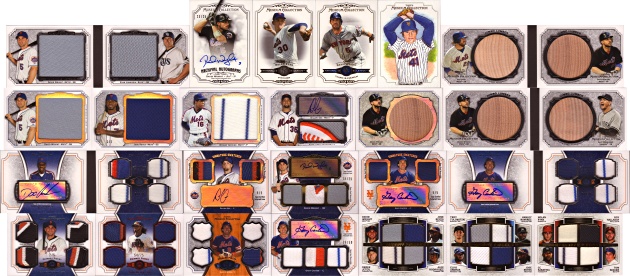
If the name Museum Collection sounds familiar, you might be remembering last years amazing framed autograph cards from 2011 Topps Marquee. This year, Museum Collection is the name of the product, with more framed autos and a few interesting changes. This time around, multi-player cards and booklets are plentiful, as are 1/1s and Jumbo Lumber bat cards (in addition to the occasional bat card in the regular jumbo relic set). The cards look better than ever, which may not mean much in a product with only one prior release, but it is still worth noting. Marquee looked good, Museum Collection looks great.
Base Set
Wait, there’s a base set? Oh, right, here’s something an eBay seller threw in as a freebie with one of the Primary Pieces Four Player Relics:

Nice try, but wrong team. Oh well. I’m sure if I take long enough to get this review out I’ll get a hold of a proper Met to use here.

Procrastination has its rewards
Even though these are base cards, they are still as thick as everything else in this product. Player selection is limited though; only David Wright and Nolan Ryan made the cut. Tom Seaver would have made more sense, but he only shows up in the Canvas Collection art card set (which are his only individual cards in this entire product, all others are with three other players).
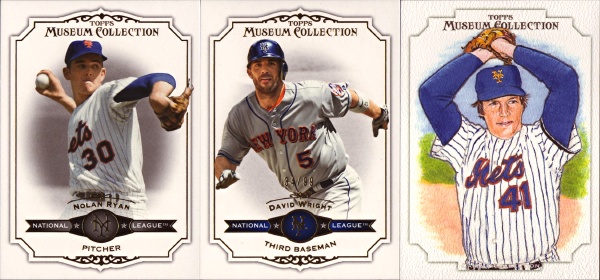
All base cards have a version with no serial number and four serial numbered variants with print runs of 299, 199, 99, and 1, while Canvas Collection cards also have parallel versions numbered to 10. Not bad for what is essentially filler in this product.
Game-Used and Autographs
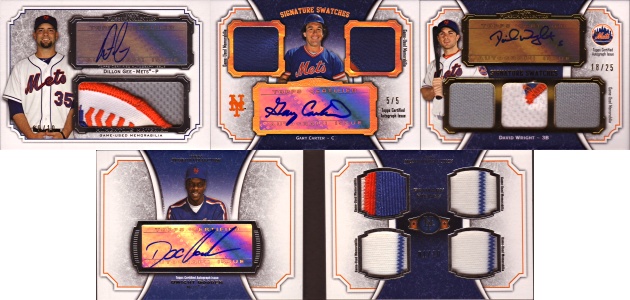
This is what people are really after in Museum Collection. Last year, 2011 Topps Marquee set the bar pretty high, getting my award for 2011 Mets Game-Used Product of the Year. So is 2012 Topps Museum Collection up to the challenge? Yes and no.
Yes, the variety of Mets cards is much improved from last year’s product, which lacked any Mets triple relic cards and had several other Metsless variant sets. Museum Collection has a Met in every major insert category except, sadly, Framed Autographs (Archival Autographs Dual and Cut Autographs are also without Mets, but those are fairly minor in comparison). This year’s product features Mets with autographs, large jerseys and bats (both alone and in two-player booklets), autographed single, double, triple, and quad memorabilia cards, and quad relics (featuring one or four players). And that’s just for David Wright.
No, the player selection is extremely limited, with David Wright representing the Mets in every game-used set and single Archival Autographs, Gary Carter and Dwight Gooden (plus Tom Seaver on the quad player relics and Nolan Ryan on his Archival Autographs cards) representing retired Mets, and Dillon Gee representing the young players. Jose Reyes is also featured as a Met on a lot of cards, while Ike Davis makes his 2012 game-used debut on a dual Jumbo Lumber relic booklet card with Wright. Nolan Ryan, Duke Snider, Willie Mays, Eddie Murray, Gary Sheffield, Carlos Beltran, and Heath Bell round out the roster with former Mets shown in other uniforms (plus a Warren Spahn Cut Autograph 1/1). It’s not a terrible list, but it is a bit light on players who are actually, you know, on the team. This is likely a consequence of moving it from a fall release to a spring release, but that really only explains Reyes. Is there nobody else on the Mets worth including? For comparison, there are 14 Yankees in the Momentous Material Jumbo Relic set alone; even the Pirates have four in that set compared to three for the Mets and eight total players shown as Mets in all of Museum Collection.
Overall, it’s not a bad mix. Between all of the different insert sets and parallels, it adds up to over 100 autographed and/or game-used cards of current or former Mets players. David Wright accounts for all or part of 28 of those and Jose Reyes adds 14 more. Once you remove the cards of players not shown as Mets, that leaves you with just 26 other Mets cards to split between Seaver, Ryan, Carter, Gooden, and Gee. The field thins out very fast in this product.
On the positive side, the few players we do get bring a lot of new material. Reyes, superfluous as he may be at this point, has his first blue jerseys in Museum Collection. I’m hoping for some large orange jerseys in next year’s product; blue and orange (even if it is from the Marlins) would look great side-by-side. Reyes’s quad jerseys also include swatches with orange or blue piping, another first (piping has become more common in recent years after apparently being stripped off prior to cutting in the early days of game-used). Dillon Gee also has his first blue jersey cards, with patch and piping variants, and David Wright got in on the piping party with a few variants of his quad jersey cards. Carter’s pinstripe jerseys are the first I’ve seen of the narrow variant of the printed zigzag stripe, calling into question everything I thought I knew about that stripe’s history, and Gooden has some great-looking dual pinstripe jersey cards. Finally, Carlos Beltran’s large jerseys were all a very off-white, indicating that they are from his Giants uniform. I would have preferred the orange swatches that some other Giants players got, but this is still good enough to call it a confirmed Giants colored jersey, the first in my collection.
Here’s the full list of Mets-related items you can pull from boxes of 2012 Topps Museum Collection (each box contains one autograph, one autographed relic, one jumbo relic, and one quad relic):
Archival Autographs

Silver: Numbered to 25
Gold: Numbered to 5
Mets: David Wright, Nolan Ryan
Non-Mets: Willie Mays
These are the base autographs in this product but are all limited-production on-card autographs of star players.
Archival Autographs Dual
Numbered to 15
Non-Mets: Willie Mays (with Hank Aaron)
Talk about a holy grail. This may be one of the best dual autographs since the Mickey Mantle / Ken Griffey Jr. card back in the ’90s. Expect to pay just shy of $1,000 if you want to pick one up.
Framed Autographs
Gold: Numbered to 15
Silver: Numbered to 10
Black: Numbered to 5
Non-Mets: Willie Mays
This year’s Framed Autographs get a three-tier parallel that brings their total production run even with the lesser Archival Autographs. I’ll assume that these look just as good as last year’s, but you really need to see them in person to fully appreciate them.
Cut Autographs
Numbered to 1
Non-Mets: Warren Spahn
Cut signature, 1/1, Hall of Famer not known for his time with the Mets.
Momentous Material Jumbo Relics
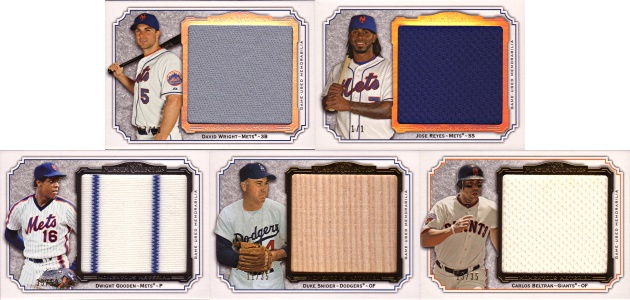
Silver: Numbered to 50
Gold: Numbered to 35
Silver Rainbow: Numbered to 10
Gold Rainbow: Numbered to 1
Mets: David Wright, Jose Reyes, Dwight Gooden
Non-Mets: Carlos Beltran, Duke Snider
I have to say, I really like the changes they made from last year’s Titanic Threads. While the size of the material is down a bit, the big square piece has much better presence and allows for a big player photo next to it. Pinstripe and colored swatches look great, too bad Wright is stuck with an old gray piece. We don’t get enough large jerseys these days, so get these while you can.
Momentous Material Jumbo Patch Relics
Numbered to 5
Mets: David Wright, Jose Reyes
Only Wright and Reyes get the patch treatment, but they are some really outstanding patches. At 5 apiece, don’t expect to have an easy time finding them.
Momentous Material Dual Jumbo Relics
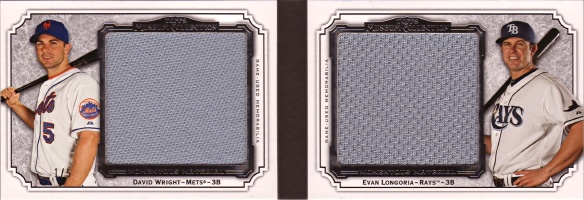
Numbered to 5
Mets: David Wright (with Evan Longoria), Jose Reyes (with Jimmy Rollins)
Non-Mets: Duke Snider (with Matt Kemp)
I don’t mind the inclusion of Longoria because a. prior to his injury, he was one of the best players in the game and b. he plays in a completely different division. The Reyes-Rollins booklet on the other hand features the shortstops of two NL East division rivals. And Ruben Tejada isn’t given a single game-used card anywhere. Otherwise, I love the idea of booklet cards as long as they don’t go nuts with it like Panini did with their infinie booklet cards. Two is plenty.
Momentous Material Jumbo Autographed Relics

Numbered to 10
Mets: David Wright, Dillon Gee, Gary Carter, Dwight Gooden
Non-Mets: Nolan Ryan, Duke Snider, Gary Sheffield
These have to be some of the most beautiful cards in this product. Not only is there an autograph and a nice big piece of patch (or, in some unfortunate cases, tag), but most patches are of the premium variety – round sleeve logos or, for Carter, the 25th Anniversary patch.
Momentous Material Jumbo Lumber Relics

Silver: Numbered to 30
Gold: Numbered to 20
Silver Rainbow: Numbered to 5
Gold Rainbow: Numbered to 1
Mets: David Wright
Non-Mets: Eddie Murray, Gary Sheffield
These are just like the regular Momentous Materials Jumbo Relics, only with a round piece of bat instead of a square piece of jersey or bat. Large bat cards are even harder to find than large jersey cards, so these are a real treat.
Momentous Material Dual Jumbo Lumber Relics

Numbered to 5
Mets: David Wright and Ike Davis, David Wright (with Alex Rodriguez)
Non-Mets: Eddie Murray (with Harmon Killebrew)
If one is good, two must be better, right? Wright is once more paired with a third baseman from the AL East (not a bad choice), but the real draw here is the Ike/Wright booklet – this is Ike Davis’s first game-used card in 2012 after a breakout 2011 with lots of jerseys and bats in Topps Marquee and Topps Triple Threads. Injury and regression hit Davis hard on the field and in the hobby. It’s still a great card though.
Signature Swatches Dual Autographed Relics

Silver: Numbering Varies
Gold: Numbered to 25
Gold Rainbow: Numbered to 5
Mets: David Wright, Dillon Gee, Gary Carter
Non-Mets: Duke Snider, Gary Sheffield
With these, you get an autograph (sticker of course) and either two swatches of jersey or bat or a jersey swatch and a piece of patch/piping/multicolor jersey. The variants numbered to 5 include two pieces of patch (if applicable). David Wright does not appear to have a silver version in this set.
Signature Swatches Triple Autographed Relics
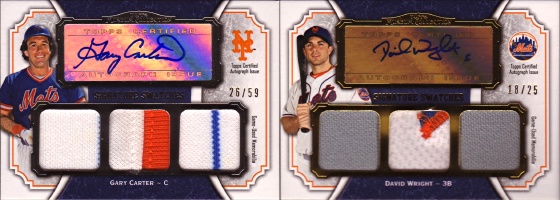
Silver: Numbering Varies
Gold: Numbered to 25
Gold Rainbow: Numbered to 5
Mets: David Wright, Gary Carter
Non-Mets: Duke Snider
Same as the duals only with three swatches and an autograph. As in the dual version, David Wright does not appear to have a silver version in this set.
Primary Pieces Quad Relics
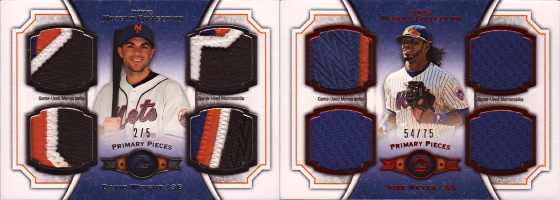
Silver: Numbered to 99
Red: Numbered to 75
Gold: Numbered to 25
Gold Rainbow: Numbered to 5
Mets: David Wright, Jose Reyes
Sadly, this year’s quad relic cards are not an improvement over last year’s. While having the jersey swatches split to the four corners of the card looks a bit better, there is very little variation between the silver, red, and gold versions. Every card has three jersey swatches (blue for Reyes, gray or white for Wright) and one swatch with a piece of patch or piping. As usual, the variants numbered to 5 are all patch swatches. With a four-tier parallel and four swatches to work with, you would think there could be a bit more variety (some of last year’s went nuts with variations, including what appeared to be a piece of Phillies patch for Beltran, which makes no sense whatsoever).
Primary Pieces Quad Autographed Relics

Numbered to 10
Mets: David Wright, Gary Carter, Dwight Gooden
Non-Mets: Duke Snider
The quad relic cards left no room for autographs, so the autographed version is in booklet form. These are hard to find and highly sought after, but that goes for most of the cards numbered to 10 or less.
Primary Pieces Four-Player Quad Relics

Silver: Numbered to 99
Red: Numbered to 75
Gold: Numbered to 25
Gold Rainbow: Numbered to 5
Mets: David Wright and Jose Reyes (with Derek Jeter and Alex Rodriguez), Jose Reyes (with Troy Tulowitzki, Hanley Ramirez, and Elvis Andrus), Tom Seaver (with Nolan Ryan, Roy Halladay, and C.C. Sabathia)
Non-Mets: Heath Bell (with Brian Wilson, Craig Kimbrel, and Mariano Rivera), Nolan Ryan (listed above)
The four-player version of the Primary Pieces insert set includes some interesting player combinations. Wright and Reyes appear together with their Yankees counterparts, Seaver makes his only game-used appearance with Nolan Ryan (Seaver’s material is from a Reds jersey while Ryan is shown as an Astros uniform), and Reyes appears again with his future (and now former) teammate Hanley Ramirez. Heath Bell also has his only game-used cards in this insert set.
Primary Pieces Quad Relics Legends

Silver: Numbered to 25
Gold: Numbered to 5
Mets: Gary Carter
Non-Mets: Willie Mays
The final Primary Pieces insert set featured some of the game’s all-time greats on a slightly different card design. Carter’s cards contained pieces from a pinstripe jersey (though many pieces did not have stripes) and Mays had a couple of quad bat cards.
And there you have it, the defending Mets Game-Used Product of the Year champion. Once again, this is clearly the bastard child of 2005 Playoff Absolute Memorabilia Tools of the Trade and 2005 SP Legendary Cuts raised by Topps. With a few more players, this could have been something truly special, instead it’s just pretty damn good. As with most premium releases, value for the money is a bit of a crap shoot, with some cards selling for less than $10 and others selling for $1000 or more. I’ll stick with singles on the secondary market over boxes/packs. Compared to the premium products that followed it in 2012, Museum Collection looks pretty strong. The variety of players and material is much better than the offerings in Tier One and Five Star and Triple Threads, despite having a better player selection, can’t compete with the quality and availability of the game-used in Museum Collection. All have their strong points, but I think Museum Collection comes out on top.
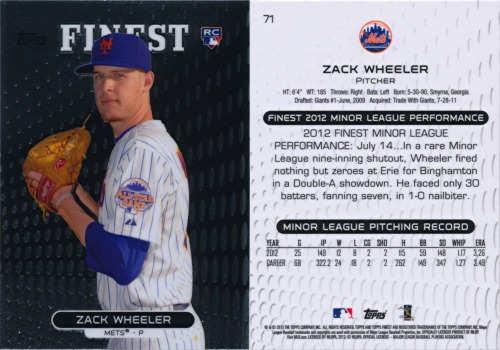
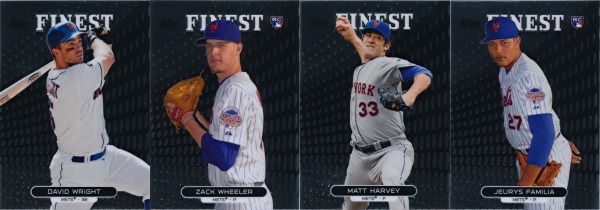
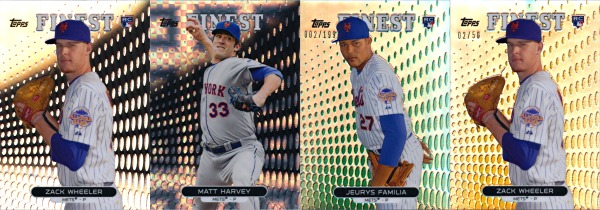
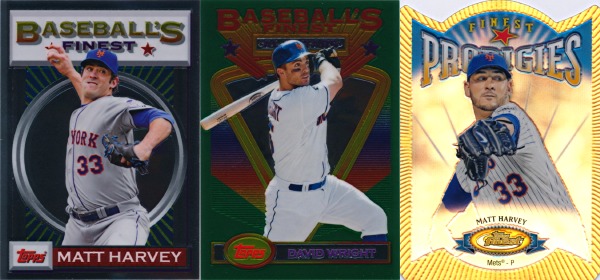
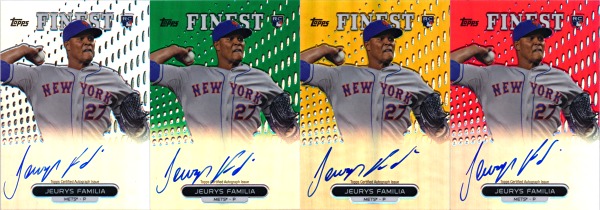
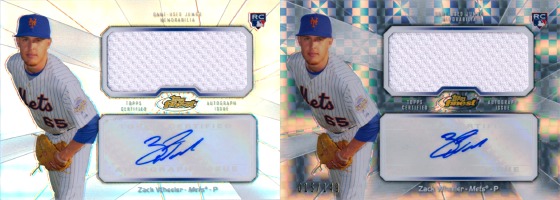
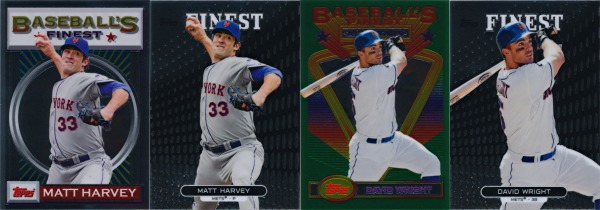
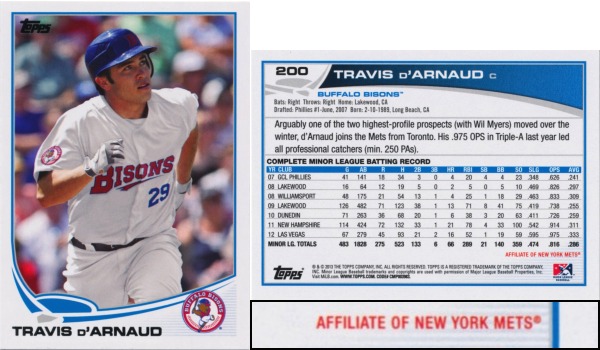
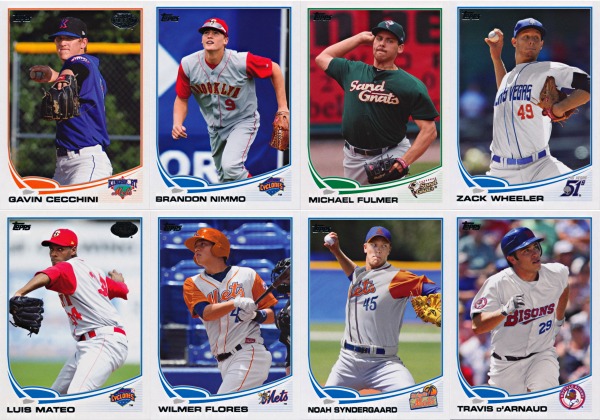
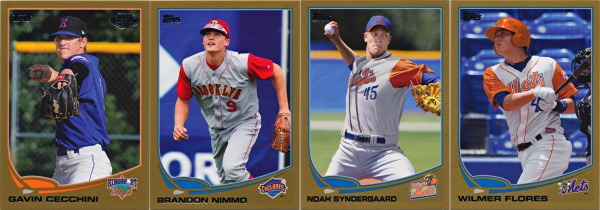
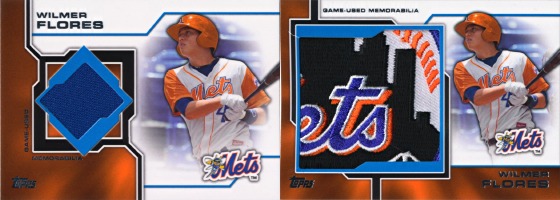

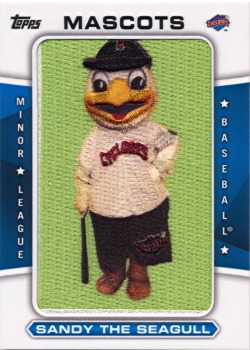
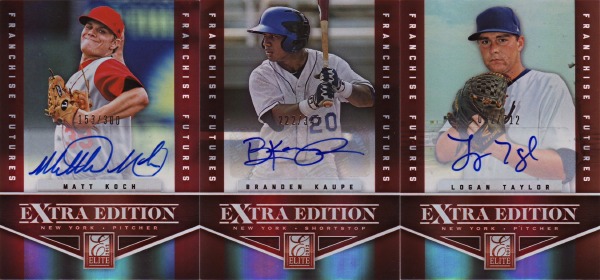
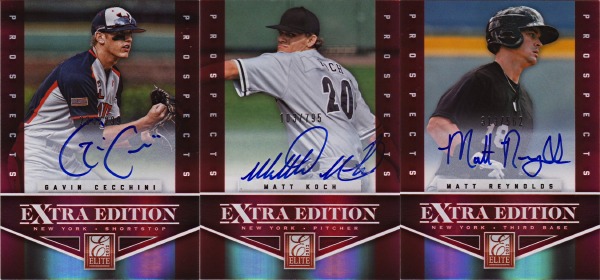
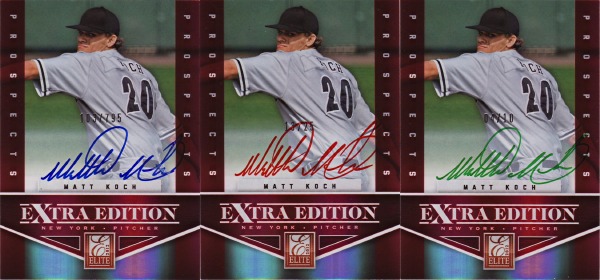
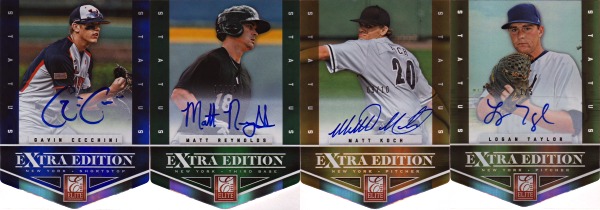
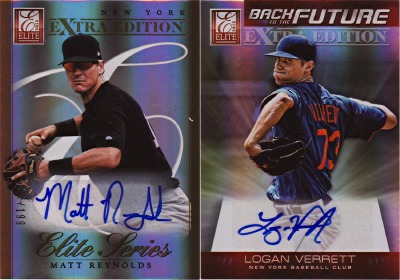
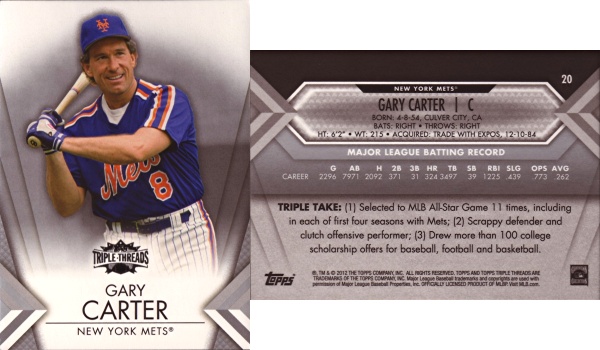
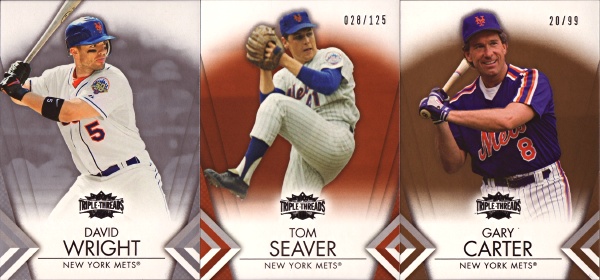

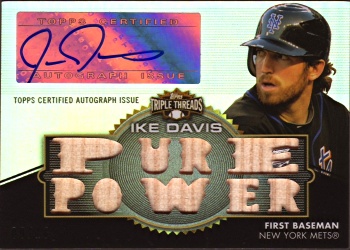
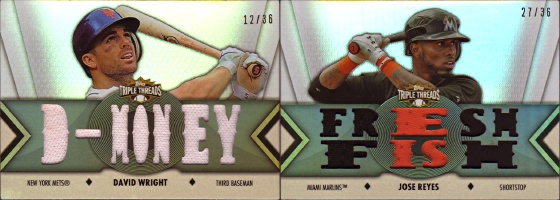

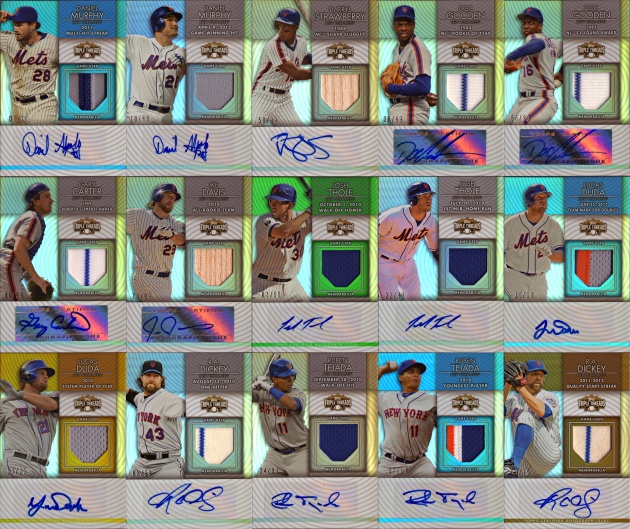
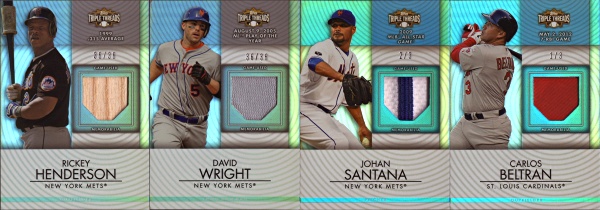
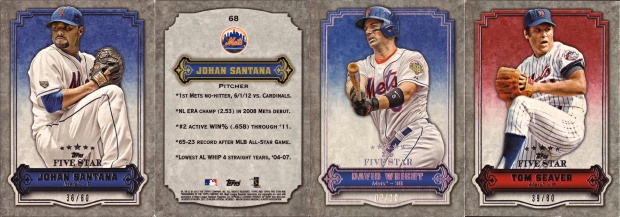
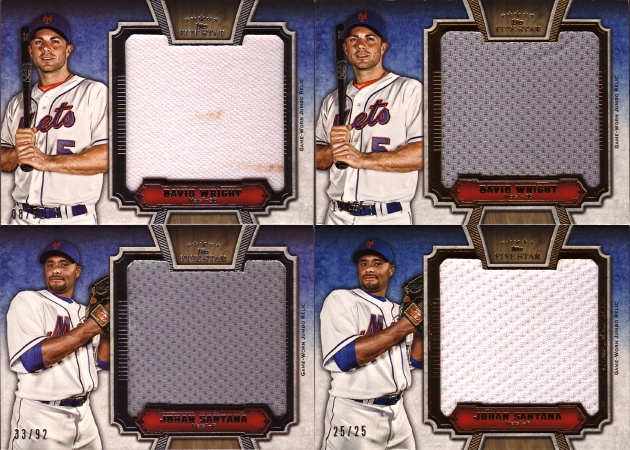
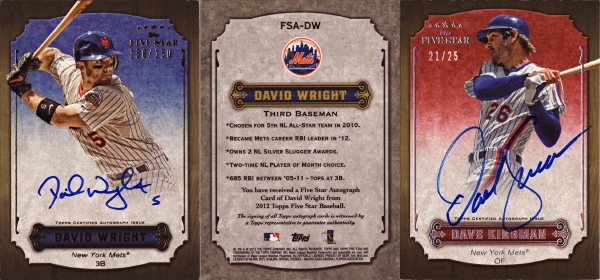
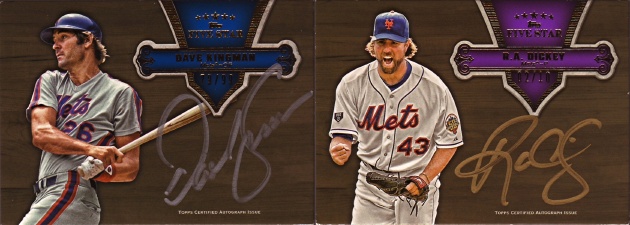

















Recent Comments